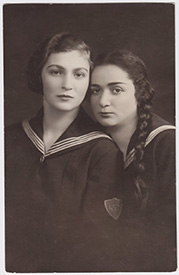Arts
Exhibit
A Town Known as Auschwitz

When the The Museum of Jewish Heritage–a Living Memorial to the Holocaust in New York opened its doors in 1997, its planners insisted that any exhibition on the Holocaust would also dwell on, and celebrate, the vibrant Jewish life that preceded the Shoah. The current exhibition at the museum, “A Town Known as Auschwitz,” admirably fulfills that injunction.
The exhibition, designed by a team headed by curator Shiri Sandler and design consultant Yvette Lenhart, calls to mind small-town Eastern Europe before World War II. According to Sandler, “We wanted the visitor to feel as if he or she were walking into a town square.” The multi-angled walls covered by slightly faded murals convey this atmosphere by adding a “watercolor effect,” says Sandler, as though “painted” to provide an impressionistic image evoking village life as it evolved from the middle ages to modern times.
The exhibition, surely inadvertently, highlights an issue that might have been ripped from today’s headlines about ethnic Russians in Ukraine. At its beginnings, the small Polish town of Oświęcim attracted a community of ethnic Germans, who called the town by a German name, Auschwitz. Centuries later, after the German occupation of Poland in 1939, the Nazis had no compunction about annexing the town, justifying that move by referring to the German ethnic population that had lived there.
For the Jews, however, the town was neither Auschwitz nor Oświęcim but, rather, Oshpitzin, an Aramaic word connoting hospitality, familiar from the Sukkot holiday, when ushpizin, distinguished biblical “guests,” are invited into the booths where the harvest holiday is celebrated. The exhibition does point out that governmental limitations on Jewish economic, social and educational progress were often signs of blatant anti-Semitism. Nevertheless, over the centuries, Jews flourished, both economically and socially. The exhibition features a number of telling photographs: of a meeting of the Jewish and gentile members of the board of education of the town’s public schools; of two high-school girls—best friends—one Jewish and one gentile; of a group of healthy Jewish girls from the Zionist sports club performing a pyramid; of a 2,000-seat Great Synagogue (eventually reduced to rubble by the Nazis).
The section of the exhibit dealing with 1939-1944 provides a horribly cogent reminder of what the name Auschwitz has come to mean, not only to the Jews but to the world at large: Utter destruction is obviously too mild an expression for it.
Today, there are no Jews left in Auschwitz/Oświęcim/Oshpitzin. But this exhibit does not permit utter forgetfulness. The one remaining synagogue—the Chevra Lomdei Mishnayot—has been refurbished, along with two other buildings. These buildings perform an educational role as the Auschwitz Jewish Center (an affiliate of the Museum of Jewish Heritage). Sandler is the center’s United States director.
For an online tour of the Auschwitz Jewish Center, go to www.oshpitzin.pl. This site contains an interactive display of the town’s historic sites. Just mouse over the images on the site’s map and you will see an informative expansion of the exhibit. You can also download an app for a tour by Smartphone. Through summer 2015 at The Museum of Jewish Heritage–a Living Memorial to the Holocaust in New York (646-437-4202).










 Facebook
Facebook Instagram
Instagram Twitter
Twitter
Leave a Reply